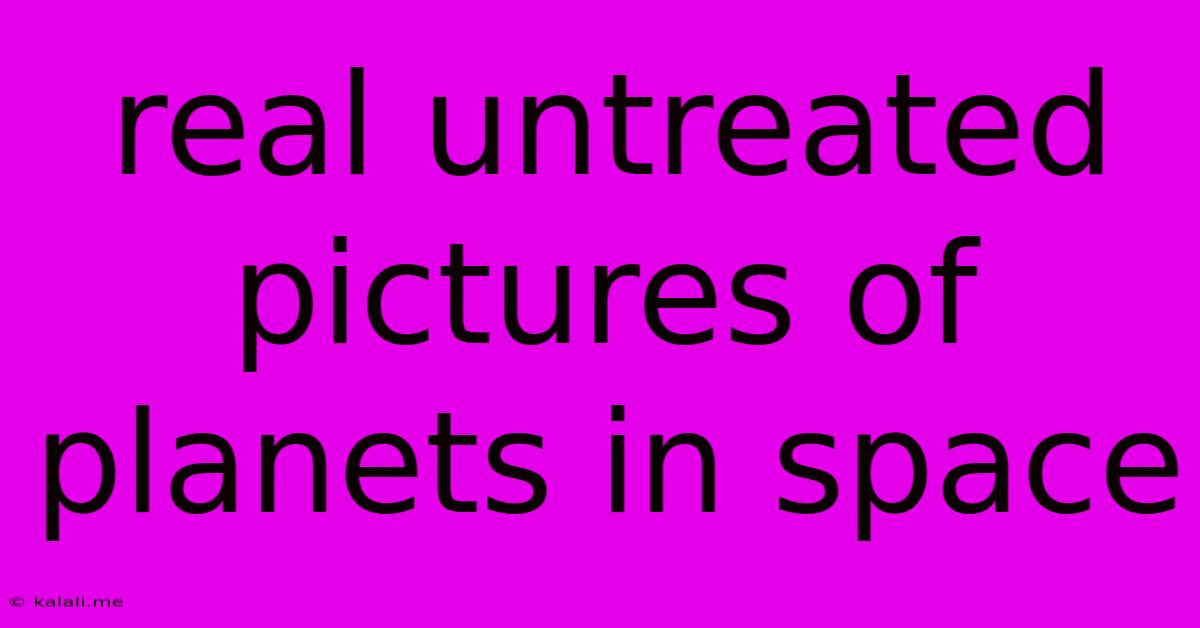Real Untreated Pictures Of Planets In Space
Kalali
May 24, 2025 · 3 min read

Table of Contents
Real Untreated Pictures of Planets in Space: A Look Beyond the Processed Images
We're bombarded with stunning, vibrant images of planets. These captivating visuals, often featured in documentaries and textbooks, showcase incredible detail and color. But how much of what we see is truly representative of what a human eye would observe if positioned in space? This article explores the reality behind these images, revealing the difference between processed images and what raw, untreated pictures of planets actually look like. The truth is far more fascinating – and subtle – than you might think.
The breathtaking images we often see are the result of significant post-processing. Scientists and image processing specialists enhance the raw data captured by telescopes and spacecraft to reveal details otherwise invisible to the human eye, improving visibility and scientific analysis. This process is essential for scientific discovery, but it can sometimes alter the true colors and contrasts.
The Challenges of Capturing Raw Planetary Images
Raw images from space often appear less visually striking than processed images. This is due to several factors:
- Low Light Conditions: Space is incredibly dark. Capturing enough light to create a detailed image requires long exposure times, often resulting in faint, grainy images.
- Data Compression: The sheer volume of data transmitted from spacecraft requires compression, leading to a loss of some detail in the raw images.
- Atmospheric Interference: Even in space, dust, gas, and other particles can interfere with the clarity of images.
- Color Calibration: The raw data often needs adjustments to accurately represent the colors of a planet, especially considering the difference between the sensors used and human vision.
What Untreated Images Look Like
Imagine looking through a powerful telescope with minimal light – that's closer to the reality of a raw image. The planets wouldn't necessarily appear as vibrant and colorful as in processed images. Instead, you might see:
- Muted Colors: Instead of the intense blues of Neptune or the fiery reds of Mars, the colors would be more subdued, even somewhat grayish in some cases.
- Grainy Texture: The images would likely have a noticeable grain or noise, similar to an old photograph.
- Lack of Sharp Detail: Fine details would be less distinct, especially in fainter regions of the image.
Why Post-Processing is Crucial
While raw images provide valuable scientific data, post-processing is essential for several reasons:
- Enhanced Visibility: Highlighting subtle features and details makes it easier for scientists to study planetary surfaces, atmospheres, and other aspects.
- Color Correction: Scientists adjust the color balance to accurately represent the true colors of a planet, based on spectral analysis.
- Noise Reduction: Post-processing techniques remove noise and artifacts from the raw images, improving clarity.
- Data Visualization: Processed images make it easier to share scientific findings with the public, fostering understanding and appreciation for space exploration.
The Importance of Transparency
It's crucial to understand the difference between raw and processed images to appreciate the scientific effort behind the breathtaking visuals we encounter. Scientists are increasingly transparent about their image processing techniques, acknowledging the role of enhancement and the importance of understanding the limitations of what we can directly observe. While the processed images are stunning and helpful for visualization, a glimpse at the "untreated" data helps us to appreciate the challenges of observing the universe and the sophisticated techniques used to interpret it. The raw images, in their subtlety, offer a unique perspective on the reality of space exploration.
Latest Posts
Latest Posts
-
How To Break Down Junk In Fallout 4
May 24, 2025
-
Can You Run Out Of Oxygen In A Car
May 24, 2025
-
Deployment Does Not Have Minimum Availability
May 24, 2025
-
How To Reply If Someone Is Not Feeling Well Professionally
May 24, 2025
-
I See Said The Blind Man Whole Quote Origin
May 24, 2025
Related Post
Thank you for visiting our website which covers about Real Untreated Pictures Of Planets In Space . We hope the information provided has been useful to you. Feel free to contact us if you have any questions or need further assistance. See you next time and don't miss to bookmark.